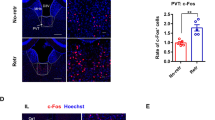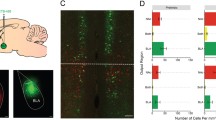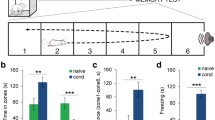Abstract
The basolateral amygdala complex (BLA) and infralimbic region of the prefrontal cortex (IL) play distinct roles in the extinction of Pavlovian conditioned fear in laboratory rodents. In the past decade, research in our laboratory has examined the roles of these brain regions in the re-extinction of conditioned fear: i.e., extinction of fear that is restored through re-conditioning of the conditioned stimulus (CS) or changes in the physical and temporal context of extinction training (i.e., extinction of renewed or spontaneously recovered fear). This paper reviews this research. It has revealed two major findings. First, in contrast to the acquisition of fear extinction, which usually requires neuronal activity in the BLA but not IL, the acquisition of fear re-extinction requires neuronal activity in the IL but can occur independently of neuronal activity in the BLA. Second, the role of the IL in fear extinction is determined by the training history of the CS: i.e., if the CS was novel prior to its fear conditioning (i.e., it had not been trained), the acquisition of fear extinction does not require the IL; if, however, the prior training of the CS included a series of CS-alone exposures (e.g., if the CS had been pre-exposed), the acquisition of fear extinction was facilitated by pharmacological stimulation of the IL. Together, these results were taken to imply that a memory of CS-alone exposures is stored in the IL, survives fear conditioning of the CS, and can be retrieved and strengthened during extinction or re-extinction of that CS (regardless of whether the extinction is first- or second-learned). Hence, under these circumstances, the initial extinction of fear to the CS can be facilitated by pharmacological stimulation of the IL, and re-extinction of fear to the CS can occur in the absence of a functioning BLA.

Similar content being viewed by others
References
Anglada-Figueroa D, Quirk GJ (2005) Lesions of the basal amygdala block expression of conditioned fear by not extinction. J Neurocsi 25:9680–9685
Bannerman DM, Good MA, Butcher SP, Ramsay M, Morris RGM (1995) Distinct components of spatial learning revealed by prior training and NMDA receptor blockade. Nature 378:182–186
Benarroch EE (2012) Periaqueductal gray: an interface for behavioral control. Neurology 8:210–217
Berretta S, Pantazopoulos H, Caldera M, Pantazopoulos P, Paré D (2005) Infralimbic cortex activation increases c-Fos expression in intercalated neurons of the amygdala. Neuroscience 132:943–953
Bloodwood DW, Sugam JA, Holmes A, Kash TL (2018) Fear extinction requires infralimbic cortex projections to the basolateral amygdala. Transl Psychiatry 8:50. https://doi.org/10.1038/s41398-018-0106-x
Bouton ME (2004) Context and behavioral processes in extinction. Learn Mem 11:485–494
Burgos-Robles A, Vidal-Gonzalez I, Santini E, Quirk GJ (2007) Consolidation of fear extinction requires NMDA receptor-dependent bursting in the ventromedial prefrontal cortex. Neuron 53:871–880
Carpenter JK, Andrews LA, Witchraft SM, Powers MB, Smits JAJ, Hofmann SG (2017) Cognitive behavioral therapy for anxiety and related disorders: a meta-analysis of randomized placebo-controlled trials. Depress Anxiety 35:502–514. https://doi.org/10.1002/da.22728
Cho JH, Deisseroth K, Bolshakov VY (2013) Synaptic encoding of fear extinction in mPFC-amygdala circuits. Neuron 80:1491–1507. https://doi.org/10.1016/j.neuron.2013.09.025
Ciocchi S, Herry C, Grenier F, Wolff SB, Letzkus JJ, Vlachos I, Ehrlich I, Sprengel R, Deisseroth K, Stadler MB, Müller C, Lüthi A (2010) Encoding of conditioned fear in central amygdala inhibitory circuits. Nature 468(7321):277–282. https://doi.org/10.1038/nature09559
Delamater A, Westbrook RF (2014) Psychological and neural mechanisms of experimental extinction: a selective review. Neurobiol Learn Mem 108:38–51
Do-Monte FH, Manzano-Nieves G, Quiñones-Laracuente K, Ramos-Medina L, Quirk GJ (2015) Revisiting the role of infralimbic cortex in fear extinction with optogenetics. J Neurosci 35:3607–3615. https://doi.org/10.1523/JNEUROSCI.3137-14.2015
Dunsmoor JE, Niv Y, Daw N, Phelps EA (2015) Rethinking extinction. Neuron 88:47–63
Durham RC, Chambers JA, Power KG, Sharp DM, Macdonald RR, Major KA, Dow MG, Gumley AI (2005) Long-term outcome of cognitive behaviour therapy clinical trials in Central Scotland. Health Technol Assess 9(42):1–174
Duvarci S, Mamou CB, Nader K (2006) Extinction is not a sufficient condition to prevent fear memories from undergoing reconsolidation in the basolateral amygdala. Eur J Neurosci 24:249–260
Ehrlich I, Humeau Y, Grenier F, Ciocchi S, Herry C, Luthi A (2009) Amygdala inhibitory circuits and the control of fear memory. Neuron 62:757–771. https://doi.org/10.1016/j.neuron.2009.05.026
Falls WA, Miserendino MJ, Davis M (1992) Extinction of fear-potentiated startle: blockade by infusion of an NMDA antagonist into the amygdala. J Neurosci 12:854–863
Gloaguen V, Cottraux J, Cucherat M, Blackburn I (1998) A meta-analysis of the effects of cognitive therapy in depressed patients. J Affect Disord 49:59–72
Goosens KA, Maren S (2004) NMDA receptors are essential for the acquisition, but not expression, of conditional fear and associative spike firing in the lateral amygdala. Eur J Neurosci 20:537–548
Hall G, Rodriguez G (2010) Associative and nonassociative processes in latent inhibition: an elaboration of the Pearce-Hall model. In: Lubow RE, Weiner I (eds) Latent inhibition: data, theories, and applications to schizophrenia. Cambridge University Press, Cambridge, pp 114–136
Harris JA, Westbrook RF (1995) Midazolam impairs the acquisition of conditioned analgesia if rats are tested with an acute but not a chronic noxious stimulus. Brain Res Bull 39:227–233
Hart G, Harris JA, Westbrook RF (2010) Systemic or intra-amygdala infusion of the benzodiazepine, midazolam, impairs learning, but facilitates re-learning to inhibit fear responses in extinction. Learn Mem 17:210–220
Helmstetter FJ (1993) Stress-induced hypoalgesia and defensive freezing are attenuated by application of diazepam to the amygdala. Pharmacol Biochem Behav 44:433–438
Herry C, Trifilieff P, Micheau J, Lüthi A, Mons N (2006) Extinction of auditory fear conditioning requires MAPK/ERK activation in the basolateral amygdala. Eur J Neurosci 24(1):261–269
Herry C, Ciocchi S, Senn V, Demmou L, Müller C, Lüthi A (2008) Switching on and off fear by distinct neuronal circuits. Nature 454:600–606
Herry C, Ferraguti F, Singewald N, Letzkus JJ, Ehrlich I, Lüthi A (2010) Neuronal circuits of fear extinction. Eur J Neurosci 31:599–612
Holmes NM, Parkes SL, Killcross AS, Westbrook RF (2013) The basolateral amygdala is critical for learning about neutral stimuli in the presence of danger, and the perirhinal cortex is critical in the absence of danger. J Neurosci 33:13112–13125
Holmes NM, Raipuria M, Qureshi O, Killcross AS, Westbrook RF (2018) Danger changes the way the mammalian brain stores information about innocuous events: a study of sensory preconditioning in rats. eNeuro 0381-17.2017
Huff NC, Wright-Hardesty KJ, Higgins EA, Matus-Amat P, Rudy JW (2005) Context pre-exposure obscures amygdala modulation of contextual-fear conditioning. Learn Mem 12:456–460
Hugues S, Deschaux O, Garcia R (2004) Postextinction infusion of a mitogen-activated protein kinase inhibitor into the medial prefrontal cortex impairs memory of the extinction of conditioned fear. Learn Mem 11:540–543
Kim JH, Richardson R (2008) The effect of temporary amygdala inactivation on extinction and reextinction of fear in the developing rat: unlearning as a potential mechanism for extinction early in development. J Neurosci 28:1282–1290
Langton JM, Richardson R (2009) The role of context in the re-extinction of learned fear. Neurobiol Learn Mem 92:496–503
Laurent V, Westbrook RF (2008) Distinct contributions of the basolateral amygdala and the medial prefrontal cortex to learning and relearning extinction of context conditioned fear. Learn Mem 15:657–666
Laurent V, Westbrook RF (2009a) Infusion of the NMDA receptor antagonist, DL-APV, into the basolateral amygdala disrupts learning to fear a novel and a familiar context as well as relearning to fear an extinguished context. Learn Mem 16:96–105
Laurent V, Westbrook RF (2009b) Inactivation of the infralimbic but not the prelimbic cortex impairs consolidation and retrieval of fear extinction. Learn Mem 16:520–529
Laurent V, Westbrook RF (2010) Role of the basolateral amygdala in the reinstatement and extinction of fear responses to a previously extinguished conditioned stimulus. Learn Mem 17(2):86–96
Laurent V, Marchand AR, Westbrook RF (2008) The basolateral amygdala is necessary for learning but not relearning extinction of context conditioned fear. Learn Mem 15:304–314
Lay BPP, Westbrook RF, Glanzman DL, Holmes NM (2018) Commonalities and differences in the substrates underlying consolidation of first- and second-order conditioned fear. J Neurosci 38:1926–1941. https://doi.org/10.1523/JNEUROSCI.2966-17.2018
LeDoux JE (2000) Emotion circuits in the brain. Annu Rev Neurosci 23:155–184. https://doi.org/10.1146/annurev.neuro.23.1.155
LeDoux JE, Daw ND (2018) Surviving threats: neural circuit and computational implications of a new taxonomy of defensive behaviour. Nat Rev Neurosci 19:269–282. https://doi.org/10.1038/nrn.2018.22
Lee H, Kim JJ (1998) Amygdalar NMDA receptors are critical for new fear learning in previously fear-conditioned rats. J Neurosci 18:8444–8454
Leidl DM, Lay BPP, Chakouch C, Westbrook RF, Holmes NM (2018) Protein synthesis in the basolateral amygdala complex is required for consolidation of a first-order fear memory, but not for consolidation of a higher-order fear memory. Neurobiol Learn Mem (in press)
Li XF, Stutzmann GE, LeDoux JE (1996) Convergent but temporally separated inputs to lateral amygdala neurons from the auditory thalamus and auditory cortex use different postsynaptic receptors: in vivo intracellular and extracellular recordings in fear conditioning pathways. Learn Mem 3:229–242
Lingawi NW, Westbrook RF, Laurent V (2017a) Extinction of relapsed fear does not require the basolateral complex. Neurobiol Learn Mem 138:149–156
Lingawi NW, Westbrook RF, Laurent V (2017b) Extinction and latent inhibition involve a similar form of inhibitory learning that is stored in and retrieved from the infralimbic cortex. Cereb Cortex 27:5547–5556
Lingawi NW, Holmes NM, Westbrook RF, Laurent V (2018) The infralimbic cortex encodes inhibition irrespective of motivational significance. Neurobiol Learn Mem 150:64–74
Lu KT, Walker DL, Davis M (2001) Mitogen-activated protein kinase cascade in the basolateral nucleus of amygdala is involved in extinction of fear-potentiated startle. J Neurosci 21:RC162
Mao SC, Hsiao YH, Gean PW (2006) Extinction training in conjunction with a partial agonist of the glycine site on the NMDA receptor erases memory trace. J Neurosci 26:8892–8899
Marek R, Strobel C, Bredy TW, Sah P (2013) The amygdala and prefrontal cortex: partners in the fear circuit. J Physiol 591:2381–2391
Milad MR, Quirk GJ (2002) Neurons in medial prefrontal cortex signal memory for fear extinction. Nature 420:70–74
Morawska MM, Fendt M (2012) The effects of muscimol and AMN082 injections into the medial prefrontal cortex on the expression and extinction of conditioned fear in mice. J Exp Biol 215:1394–1398. https://doi.org/10.1242/jeb.068213
Olucha-Bordonau FE, Fortes-Marco L, Otero-Garcia M, Lanuza E, Martinez-Garcia F (2015) Amygdala: structure and function. In: Paxinos G (ed) The rat nervous system. Academic Press, pp 442–490
Onoue K, Nakayama D, Ikegaya Y, Matsuki N, Nomura H (2014) Fear extinction requires Arc/Arg3.1 expression in the basolateral amygdala. Mol Brain 7:30
Pape HC, Paré D (2010) Plastic synaptic networks of the amygdala for the acquisition, expression, and extinction of conditioned fear. Physiol Rev 90:419–463. https://doi.org/10.1152/physrev.00037.2009
Paré D (2004) Presynaptic induction and expression of NMDA-dependent LTP. Trends Neurosci 27:440–441
Paré D (2009) Amygdala: structure and circuitry in rodents and felines. In: Squire L (ed) Encyclopedia of neuroscience. Academic Press, pp 347–353
Pare D, Duvarci S (2012) Amygdala microcircuits mediating fear expression and extinction. Curr Opin Neurobiol, 22(4):717-23. https://doi.org/10.1016/j.conb.2012.02.014
Parkes SL, Westbrook RF (2010) The basolateral amygdala is critical for the acquisition and extinction of associations between a neutral stimulus and a learned danger signal but not between two neutral stimuli. J Neurosci 30:12608–12618. https://doi.org/10.1523/JNEUROSCI.2949-10.2010
Parsons RG (2017) Behavioral and neural mechanisms by which prior experience impacts subsequent learning. Neurobiol Learn Mem. https://doi.org/10.1016/j.nlm.2017.11.008
Pedroso TR, Jobim PF, Carvalho LM, Christoff RR, Maurmann N, Reolon GK, Werenicz A, Roesler R (2013) Inhibition of protein synthesis or mTOR in the basolateral amygdala blocks retrieval-induced memory strengthening. J Neural Transm 120:1525–1531
Rescorla RA (2001) Retraining of extinguished Pavlovian stimuli. J Exp Psychol Anim Behav Process 27:115–124
Rescorla RA, Wagner AR (1972) A theory of Pavlovian conditioning: variations in the effectiveness of reinforcement and nonreinforcement. In: Black AH, Prokosy WF (eds) Classical conditioning II: current research and theory. Appleton-Century-Crofts, New York, pp 64–99
Rhodes SE, Killcross S (2004) Lesions of rat infralimbic cortex enhance recovery and reinstatement of an appetitive Pavlovian response. Learn Mem 11(5):611–616
Rhodes SE, Killcross S (2007) Lesions of rat infralimbic cortex enhance renewal of extinguished appetitive Pavlovian responding. Eur J Neurosci 25(8):2498–2503
Sah P, Faber ESL, Lopez de Armentia M, Power J (2003) The amygdaloid complex: anatomy and physiology. Physiol Rev 83:803–834
Saucier D, Cain DP (1995) Spatial learning without NMDA receptor-dependent long-term potentiation. Nature 378:186–189
Senn V, Wolff SB, Herry C, Grenier F, Ehrlich I, Grundemann J, Fadok JP, Muller C, Letzkus JJ, Luthi A (2014) Long-range connectivity defines behavioral specificity of amygdala neurons. Neuron 81(1):428–437
Sotres-Bayon F, Bush DE, LeDoux JE (2007) Acquisition of fear extinction requires activation of NR2B-containing NMDA receptors in the lateral amygdala. Neuropsychopharmacology 32:1929–1940
Swanson LW (2000) Cerebral hemisphere regulation of motivated behavior. Brain Res 886:113–164
Vidal-Gonzalez I, Vidal-Gonzalez B, Rauch SL, Quirk GJ (2006) Microstimulation reveals opposing influences of prelimbic and infralimbic cortex on the expression of conditioned fear. Learn Mem 13:728–733
Westbrook RF, Bouton ME (2010) Latent inhibition and extinction: their signature phenomena and the role of prediction error. In: Lubow RE, Weiner I (eds) Latent inhibition: cognition, neuroscience, and applications to schizophrenia. Cambridge University Press, New York, pp 23–39
Wu IT, Tang TH, Ko MC, Chiu CY, Lu KT (2015) Amygdaloid zif268 participated in the D-cycloserine facilitation effect on the extinction of conditioned fear. Psychopharmacology 232:3809–3819
Author information
Authors and Affiliations
Corresponding author
Ethics declarations
Conflict of interest
The authors declare that they have no conflict of interest.
Additional information
This article belongs to a Special Issue on Psychopharmacology of Extinction.
Rights and permissions
About this article
Cite this article
Lingawi, N.W., Laurent, V., Westbrook, R.F. et al. The role of the basolateral amygdala and infralimbic cortex in (re)learning extinction. Psychopharmacology 236, 303–312 (2019). https://doi.org/10.1007/s00213-018-4957-x
Received:
Accepted:
Published:
Issue Date:
DOI: https://doi.org/10.1007/s00213-018-4957-x




